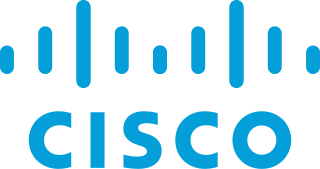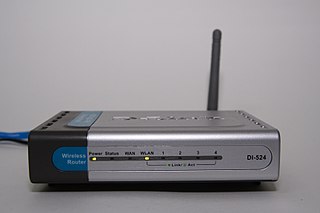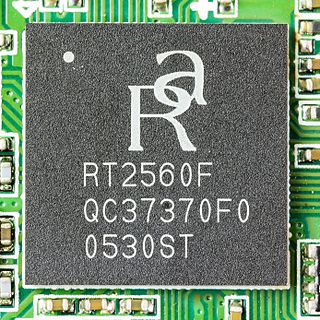Microsoft Broadband Networking was a series of computer networking hardware products marketed by Microsoft from 2002 through 2004.

A computer network is a digital telecommunications network which allows nodes to share resources. In computer networks, computing devices exchange data with each other using connections between nodes. These data links are established over cable media such as wires or optic cables, or wireless media such as Wi-Fi.

Microsoft Corporation (MS) is an American multinational technology company with headquarters in Redmond, Washington. It develops, manufactures, licenses, supports and sells computer software, consumer electronics, personal computers, and related services. Its best known software products are the Microsoft Windows line of operating systems, the Microsoft Office suite, and the Internet Explorer and Edge web browsers. Its flagship hardware products are the Xbox video game consoles and the Microsoft Surface lineup of touchscreen personal computers. As of 2016, it is the world's largest software maker by revenue, and one of the world's most valuable companies. The word "Microsoft" is a portmanteau of "microcomputer" and "software". Microsoft is ranked No. 30 in the 2018 Fortune 500 rankings of the largest United States corporations by total revenue.
In July 2002 Microsoft product managers stated that home networking was too hard to use, and the company was developing products using the Institute of Electrical and Electronics Engineers (IEEE) 802.11b standard (sold under the Wi-Fi name). [1] Products announced in September included the MN-500 wireless base station, MN-510 WiFi Universal Serial Bus (USB) network interface controller and MN-520 PC Card for laptop computers. [2] The MN-500 served as a wireless access point, a router, and included an Ethernet hub with four 10/100 Ethernet ports. A five port Ethernet switch and Ethernet network interface controller cards were announced, along with kits. [2] Reviews noted the reasonable prices and simple interface, although the configuration software would sometimes fail. [3] One reviewer noted the 96-page book included with the base station. [4] It was one of the first products to enable Wired Equivalent Privacy (WEP) by default, which provided at least some level of privacy. Software included a setup wizard, a broadband network utility (BNU) and an auto-update feature. [5] According to codes in the documentation, the initial MN-510 was developed by Accton Technology Corporation. Features were similar to products of SMC Networks, a subsidiary of Accton. [6]

A home network or home area network (HAN) is a type of computer network that facilitates communication among devices within the close vicinity of a home. Devices capable of participating in this network, for example, smart devices such as network printers and handheld mobile computers, often gain enhanced emergent capabilities through their ability to interact. These additional capabilities can be used to increase the quality of life inside the home in a variety of ways, such as automation of repetitive tasks, increased personal productivity, enhanced home security, and easier access to entertainment.

The Institute of Electrical and Electronics Engineers (IEEE) is a professional association with its corporate office in New York City and its operations center in Piscataway, New Jersey. It was formed in 1963 from the amalgamation of the American Institute of Electrical Engineers and the Institute of Radio Engineers.
IEEE 802.11b-1999 or 802.11b, is an amendment to the IEEE 802.11 wireless networking specification that extends throughput up to 11 Mbit/s using the same 2.4GHz band. A related amendment was incorporated into the IEEE 802.11-2007 standard.
By January 2003 it was estimated the products were in the number two position in US retail sales for Wi-Fi products. However market share declined by February when introduction of faster products based on IEEE 802.11g standards were delayed. Market leader Linksys was purchased by Cisco Systems in March. NetGear and D-Link also gained market share in 2003. [7] The MN-700 model supporting 802.11g was available in September. [8] A new PC card for 802.11g was also available. Reviews noted easy setup, but limited features compared to competitors. [9] Microsoft discontinued the line in May 2004. [10]

Linksys is an American company selling data networking hardware products mainly to home users and small businesses. Its products include wired and wireless routers, Ethernet switches, VoIP equipment, wireless Internet video cameras, audio visual products and network storage systems.

Cisco Systems, Inc. is an American multinational technology conglomerate headquartered in San Jose, California, in the center of Silicon Valley. Cisco develops, manufactures and sells networking hardware, telecommunications equipment and other high-technology services and products. Through its numerous acquired subsidiaries, such as OpenDNS, WebEx, Jabber and Jasper, Cisco specializes into specific tech markets, such as Internet of Things (IoT), domain security and energy management.
D-Link Corporation is a Taiwanese multinational networking equipment manufacturing corporation headquartered in Taipei, Taiwan. It was founded in March 1986 in Taipei as Datex Systems Inc.














